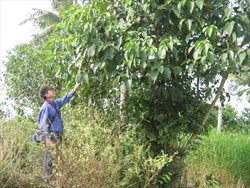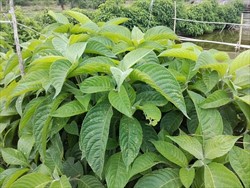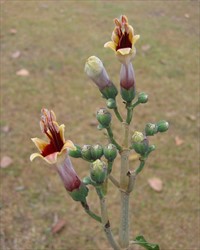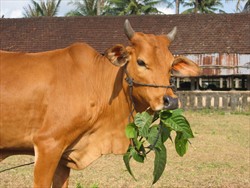Tropical Forages
None listed in GRIN.
Ruellia gigantea Humb. & Bonpl. cited in The Plant List.
Family: Acanthaceae subfamily: Acanthoideae tribe: Ruellieae.
A shrub or small tree to 5 m, occasionally up to 15 m, with a rounded crown. Branches quadrate with rounded angles, i.e. with very pronounced nodes, the tips covered with minute brown hairs. Leaves ovate to oblong, narrowing at both ends and concave approaching the apex, 26 × 14 cm; hairless or pubescent along the venation; petioles 1‒5 cm long. Inflorescence a compact terminal panicle 5‒15 cm long. Flowers have small triangular bracts to 3 mm; calyx 10‒12 mm long with segments 10 × 5 mm and rounded at the apex. Corolla red and hairless near the axis, and yellowish with short silky hairs furthest from the axis, 3‒4 cm long. Fruits contain 35‒40 seeds each. 4 million seeds per kg.
Wood is light and very soft, with pith large and septate. In common with other acanthaceous plants, T. gigantea has small mineral concretions called cystoliths, appearing as minute short lines on the upper surface of the leaf blades, the upper portions of the stems, on the branches of the inflorescence and on the calyx.
Asia: chè đại, trà lá to (Vietnam)
English: trichanthera
Latin America: beque, pau santo (Brazil); aro, aro blanco, cajeto, cenicero, fune, madre de agua, nacedero, naranjillo, palo de agua, quiebrabarrigo, rompebarriga, suiban, tricantera, tuno (Spanish)
Native:
Central America: Costa Rica, Panama
South America: Colombia, Ecuador, Peru, Venezuela
Forage
Used as a cut-and-carry forage for ruminants and monogastrics.
Environment
Its environmental value is through its use in reducing stream bank erosion. It is also be used as a living fence and shade tree.
Other
Used as a medicinal plant to treat colic and hernia in horses, retained placenta in cows, and intestinal obstrutions in domestica animals more generally. Its green stems are reported to be used in treating nephritis in humans. Used in some regions as a lactogenic drink for nursing mothers.
Soil requirements
Requires fertile, well drained soils but is also reported to adapt to acid, infertile soils of pH down to 4.5.
Moisture
Adapted to 1,500‒3,000 mm annual rainfall environments with outer limits of 1,000 mm and over 5,000 mm. Although common to stream banks, it requires well-drained soils. Will drop its leaves during dry periods, but leaves regrow rapidly following rain.
Temperature
A lowland species from the humid tropics, trichanthera performs best at mean temperatures of approximately 30 °C. It does not tolerate frost.
Light
Has considerable shade tolerance. Higher yields under shade than in full sunlight are reported from Vietnam and Nicaragua. Advantage has been made of shade tolerance by growing trichanthera under leucaena (Leucaena spp.) and other agroforestry species. Stem cuttings will readily form roots in full sun or in light shade.
Reproductive development
Flowers from January to April, especially in February and March. Fruits mature quickly, the first usually by February, and may be found on the same inflorescence with flowers. Obligate outcrossing species pollinated by bats, birds, ants and large bees. Germination percentage is very low, at 0‒2%. Propagation is generally by stem cuttings.
Defoliation
Tolerant of regular defoliation by cutting. Suggested cutting height: 60 cm; cutting frequency for yield and quality optimization: every 3 months. Because of the fragility of stems, grazing is not recommended.
Fire
No information available but based on the species´ typical habitat, probably no fire tolerance.
Guidelines for establishment and management of sown forages.
Establishment
Generally established from stem cuttings that strike roots easily. Cuttings 2.2‒2.8 mm in diameter, 20 cm long and with at least 2 leaf buds were most effective in striking roots (92% of cuttings). Larger and longer cuttings are less successful. Cuttings should be selected from the basal part of young stems. Strike rate has been improved by storing cuttings in a shaded place for one day prior to planting into a nursery bed. Cuttings produce shoots in about one month and can be planted into the field after about 50 days. Spacings vary from 0.5 to 1.0 m apart and planting can be in a block or as a twin-hedgerow along fence lines.
Fertilizer
Responds well to fertilizer application. In Vietnam, DM yield increased from 5 to 9 t/ha when manure application was increased from 15 to 30 t/ha. In low fertility soils, produces an almost linear response to N fertilizer up to 240 kg N/ha, with an optimum return on costs at 160 kg N/ha. The vigorous regrowth of trichanthera under heavy cutting regimes has led to speculation that N-fixation may occur through the action of actinomycetes or other organisms.
Compatibility (with other species)
Once established it competes well with surrounding vegetation.
Companion species
Can be grown in association with a range of over-story agroforestry species due to its shade tolerance. Has been grown underneath bananas, Leucaena and Gliricidia.
Pests and diseases
No major pests or diseases are reported.
Ability to spread
Stems that contact the ground, either through bending or breakage, will root at the nodes to form new plants. Spread is very slow and will not occur under regular cutting.
Weed potential
Weed potential is unknown, but is likely to be very limited due to the poor germinability of seed and the slow spread from stems.
Nutritive value
Moderate to high nutritive quality depending on provenance. Contains high concentrations of water-soluble carbohydrates and starch, and low NDF. CP content ranges from 12 to 22%, IVDMD from 45 to 60% and 24 hr in sacco DMD from 50 to 70%. Contains comparatively high ash and calcium concentrations at 16‒20% and 2.4‒3.8% of DM, respectively. The high ash and Ca concentrations may be related to the presence of cystoliths, small mineral concretions on the leaves and stems. Suitable as a feed for non-ruminants.
Palatability/acceptability
Well accepted by a range of domestic animals, including pigs and other monogastrics, after a period of familiarisation. Palatability may change with provenance. Trichanthera is a relatively new forage in terms of international evaluation. There are conflicting anecdotes regarding its palatability to ruminant livestock, but this may simply be an issue of familiarisation. Considerably more work is required to determine best provenances for forage production and to assess livestock production.
Toxicity
None reported. Contains no saponins or condensed tannins, but contains varying concentrations of steroids and other phenolic compounds, possibly including hydrolysable tannins. Concentrations vary with provenance.
Feedipedia link
Dry matter
Yields of up to 12 t DM/ha/year obtained during 4 cuts in favourable environments have been reported. As a living fence planted as a twin hedgerow at 1 × 1 m spacing, trichanthera has produced 9.2 t fresh matter/linear km/year.
Animal production
LWG of young bulls of 618 g/day are reported from Venezuela when chopped grass was supplemented with trichanthera vs. 509 g without supplement. Reasonable LWGs for 35-day old New Zealand rabbits were obtained by replacing 30% of concentrate feed with trichanthera. Although the feed conversion ratio was poorer using trichanthera (4.3 compared with 3.5 for concentrate feed), the LWG remained constant at 32 g/day.
A study of 22 provenances of identified considerable variation in DM production and forage quality. Provenances from Cauca Valley in Colombia had high IVDMD and low biomass production, whereas those from Venezuela had low IVDMD and high biomass production. Genetic studies in the Colombian collection revealed high diversity.
Seed is very small and is produced in small fruits weighing about 0.9 g each and containing 35‒40 seeds.
No information available.
- Relatively high nutritive quality.
- Shade tolerant.
- Ease of establishment by cuttings.
- Poor low temperature tolerance.
- Poor dry season growth.
- Poor palatability to naïve livestock.
Posso Terranova, A.M., Cárdenas Henao, H., Murgueitio, E., Leterme, P. and Muñoz Flórez, J.E. (2011) Diversidad genética de accesiones de nacedero Trichanthera gigantea (Humb. & Bonpl.) Nees, mediante RAM's (Random Amplified Microsatellites). Acta Agronomica 60(2):120–131. revistas.unal.edu.co/index.php/acta_agronomica/article/view/27834
Rosales, M. (1997) Trichanthera gigantea (Humboldt & Bonpland.) Nees: A Review. Livestock Research for Rural Development 9(4):37. lrrd.org/lrrd9/4/mauro942.htm
Ruiz-Fonseca, C.J. and Jiménez-Campos, M.A. (2005) Producción de biomasa de nacedero (Trichanthera gigantea) en diferentes escenarios de sombra y frecuencias de cortes, en el Rancho Ebenezer. Niquinohomo, Masaya. La Calera 10(14):31–38. doi.org/10.5377/calera.v10i14.25
None released.
Provenances from Cauca Valley, Colombia; in evaluation in Colombia these accessions had high IVDMD but low biomass production.
Provenances from Venezuela; in evaluation in Colombia, these accessions had low IVDMD but high biomass production.








